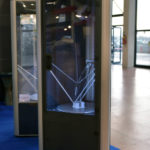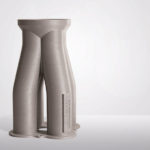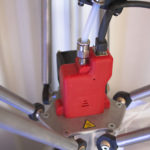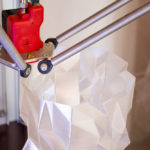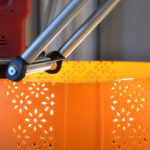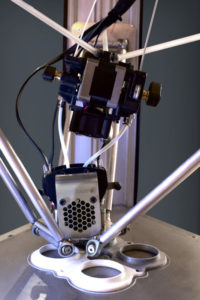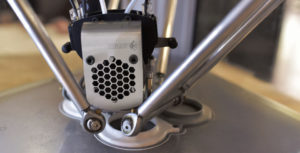WASP is 3D printer company with a mission, they think big and they build even bigger. WASP stands for World’s Advanced Saving Project, and the plucky Italian company produces some of the fastest and most accurate delta style 3D printers on the market. According to WASP, they “make 3D printers in Italy to finance our dream: to realize a 3D 12m printer able to print houses.” In fact, WASP already has created their  BigDelta 12m to start 3D printing an entire village. Their recently released DeltaWASP 3MT is large enough to 3D print furniture and they have mastered some very difficult challenges in 3D printing, such as creating a sophisticated pellet extruder for the 3MT and a clay extruder with retraction that produces some of the best ceramic prints I’ve seen. They’ve even created a Maker Economy Starter Kit that contains 6 different DeltaWASPs, from the gigantic BigDelta 12m to the desktop TopWASP DLP resin printer, enabling you to print an entire house and all its contents. It seems like WASP is constantly pushing the limits and they’ve got some exciting new products to print faster and better than before.
BigDelta 12m to start 3D printing an entire village. Their recently released DeltaWASP 3MT is large enough to 3D print furniture and they have mastered some very difficult challenges in 3D printing, such as creating a sophisticated pellet extruder for the 3MT and a clay extruder with retraction that produces some of the best ceramic prints I’ve seen. They’ve even created a Maker Economy Starter Kit that contains 6 different DeltaWASPs, from the gigantic BigDelta 12m to the desktop TopWASP DLP resin printer, enabling you to print an entire house and all its contents. It seems like WASP is constantly pushing the limits and they’ve got some exciting new products to print faster and better than before.
The DeltaWASP 40 70 Industrial Turbo2, which WASP introduced at Technology Hub in Milan last week, is an upgraded version of the standard DeltaWASP 40 70, with a full metal cover and frame. The heated build chamber features forced ventilation and is better isolated from exterior temperature and noise, enabling the DeltaWASP 40 70 to print a variety of materials including PLA, ABS, Flex, HIPS, PETG, TPU, Polypropylene (PP), ABS+PC, Nylon, and Nylon+Carbon. An internal air filtration system with activated carbon helps to contain noxious fumes. A new 32 bit board and Turbo2 double power motor doubles the speed of the traditional 40 70. It has a host of premium features including the DeltaWASP 2.0 Resurrection System to automatically re-start a print after power failure, integrated end-filament sensor, wifi 4.0, and interchangable extruders allowing you to switch between the Basic Extruder, Spitfire Extruder and Dual Extruder. You can even outfit it with WASP’s fluid-dense material extruder to 3D print with materials like clay and porcelain. The 40 70 Industrial with Turbo2 configuration has a 400 x 700 mm build area. It can print at blazing fast speeds, up to 500 mm/s, has a max nozzle temp of 260°C, max bed temp of 110°C and 100 micron resolution.
- Delta WASP 40 70 Industrial Turbo2
- DeltaWASP 20 40 Turbo2
- Print created on the DeltaWASP 20 40 Turbo2
The DeltaWASP 20 40 Turbo 2 is one of the fastest FDM printers on the market. Not only does it feature a new 32 bit board and double power motors, but it also has an advanced cooling system developed to increase print speed to 200mm/s and an incredible 1000mm/s travel speed! It has a host of advanced features like its big brother: integrated end-filament sensor, resurrection system, wifi, interchangeable extruders and a better insulated build chamber, so it can print advanced materials, too. Build volume is 200 x 400 mm. Max nozzle and heated bed temps are slightly higher, at 270°C and 120°C, respectively. Max resolution is 50 microns. Price is set at €2,770 (VAT excluded) and delivery time is 5 weeks.
WASP also released more details on their Spitfire Extruder, which I first saw at Inside 3D Printing NY 2017. Spitfire is a configurable extruder that addresses different printing needs. It allows for quick printing and has a swappable cartridge composed of the barrel and nozzle of the hotend, which is easily removable with the turn of a couple screws. There are two different types of cartridges: a low temperature cartridge (LT), which is designed for printing PLA, PETG and flexible materials like TPU, and a high temperature cartridge (HT) for printing materials that require higher temperatures or are more difficult to print, such as ABS, PA, PC, HIPS, ASA, PMMA and PP. Both cartridges have a steel barrel, and the LT cartridge is lined with Teflon, while the RT is just steel. The Spitfire can heat the nozzle up to 350°C to print even the hardest materials. There are two versions of the Spitfire Extruder: The Spitfire Black, which can be installed on the DeltaWASP 20 40, 40 70, and 60 100 printers, and there’s the Spitfire Red, which is designed for the Industrial line of printers and DeltaWASP Turbo2. The interchangeable nozzles come in 0.4mm, 0.7mm, and 1.2mm.
- Spitfire Red
Clearly WASP produces very good 3D printers that are both fast and accurate. And while the interchangeable extruder system and their extruder offerings are impressive, there’s been one thing missing from their lineup that you would want in a premium 3D printer, and that’s dual extrusion. WASP has addressed that need with the ZEN Dual Extruder, and it’s an interesting device. The ZEN essentially marries two Spitfire extruders together into one unit. DeltaWASPs use a suspended extruder motor design, sort of like a very short Bowden extruder setup that floats just above the hotends and is attached by elastic-bands to the delta’s arms, rather than directly to the platform. The ZEN Dual Extruder is able to take advantage of the lack of a direct drive motor by squeezing the two hotends very close together. What’s really unique about the system is that the nozzles are angled slightly outwards from each other. WASP solves the common problem of leveling dual extruders by using a “a totally mechanical basculating switch” instead of a motor to rotate the active hotend into position.
The ZEN also features anti-oozing flaps, so no time or material is wasted during a dual extrusion print. In theory, dual extrusion with the ZEN should be just about as quick as single extrusion with a Spitfire. The ZEN features similar swappable cartridges to the Spitfire, the ZEN Core LT and HT. Two ZEN Core LTs come with the ZEN Dual Extruder, which is compatible only with the DeltaWASP 20 40 Turbo2 and the DeltaWASP 40 70 Industrial, and is priced at €490 (VAT excluded).
- ZEN Dual Extruder
In other news, WASP and MyMiniFactory have teamed up to hold a 3D Printable Homeware Design Competition. The challenge is to design a piece of furniture or other item for the home that takes advantage of the DeltaWASP 3MT’s 900 x 900 mm build volume and other characteristics like the large print layer and colors made possible with its pellet extruder. Designs must be support free and print continuously. The top prize is a Startt 3D Printer and a full size print of your design on the DeltaWASP 3MT. The prize for 2nd through 10th place winners is a full size print of your design, but the winners must pay for the shipping costs. The winning designs will also be printed and shown at the world famous Chelsea Design Centre. Submissions close on April 28 2017, so if you want to a cool piece of 3D printed furniture you might want to get cracking on that. It certainly looks like a cool opportunity to me. What do you think about WASP’s new offerings? Discuss in the WASP forum at 3DPB.com.
[Images: WASP]Subscribe to Our Email Newsletter
Stay up-to-date on all the latest news from the 3D printing industry and receive information and offers from third party vendors.
You May Also Like
Precision at the Microscale: UK Researchers Advance Medical Devices with BMF’s 3D Printing Tech
University of Nottingham researchers are using Boston Micro Fabrication‘s (BMF) 3D printing technology to develop medical devices that improve compatibility with human tissue. Funded by a UK grant, this project...
3D Printing Webinar and Event Roundup: April 21, 2024
It’s another busy week of webinars and events, starting with Hannover Messe in Germany and continuing with Metalcasting Congress, Chinaplas, TechBlick’s Innovation Festival, and more. Stratasys continues its advanced training...
3D Printing Webinar and Event Roundup: March 17, 2024
It’s another busy week of webinars and events, including SALMED 2024 and AM Forum in Berlin. Stratasys continues its in-person training and is offering two webinars, ASTM is holding a...
3D Printed Micro Antenna is 15% Smaller and 6X Lighter
Horizon Microtechnologies has achieved success in creating a high-frequency D-Band horn antenna through micro 3D printing. However, this achievement did not rely solely on 3D printing; it involved a combination...


